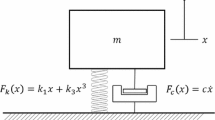Abstract
The algorithm of successive formulas for computing numerical vibrating response of unequal time interval for a single-degree of freedom oscillator in linear cases are more systematically introduced in the paper. Some numerical analysis characteristics of the algorithm are discussed. It is proved that the algorithm is unconditionally stable and convergent. A computer program for simultaneous calculation of the relative displacement, the relative velocity and the absolute acceleration response spectra is edited in the paper.
Similar content being viewed by others
References
Cheng, M. X., 1988. Convergence and stability of direct numerical integration in case of negative-yield-stiffness.Acta Mechanica Sinica,20, 1, 31–40 (in Chinese).
Cheng, M. X., 1989. Convergence and stability of several step-by-step integration method in structural dynamic analysis in case of negative-stiffness.Engineering Mechanics,6, 2, 35–47 (in Chinese).
Lee, V.W., 1984. A new fast algorithm for the calculation of response of a single-degree of freedom system to arbitrary load in time.Soil Dynamics and Earthquake Engineering,3, 4, 191–199.
Li, D. H., 1990. Successive formula method for computing earthquake response spectra.Earthquake Engineering and Engineering Vibration,10, 2, 47–52 (in Chinese).
Liu, Y. and Xie, J. F. (Editors), 1984.Sand Liquefaction by Earthquake Ground-Motion. Seismological Press, Beijing, 284–291 (in Chinese).
Nigam, N. C. and Jennings, P. C., 1969. Calculation of response spectra from strong-motion earthquake records.Bull. Seism. Soc. Am.,59, 2, 909–922.
Qian, P. F., 1983.Analysis of Aseismic Structures. Seismological Press, Beijing, 157 (in Chinese).
Wang, Q. X., 1962. A simple convenient method to evaluate response spectra. In: Liu, H. X. (Editor),Collected Papers on Earthquake Engineering of IEM,1, 1–11 (in Chinese).
Wang, Q. X. and Wang, X. X., 1983.Theory of Seismic Loads on Engineering Structures. Seismological Press, Beijing, 48–50 (in Chinese).
Zhu, J. Q., 1983. On numerical stability in the dynamic analyses of structures.Acta Mechanica Sinica,15, 1, 388–395 (in Chinese).
Author information
Authors and Affiliations
Additional information
The Chinese version of this paper appeared in the Chinese edition ofActa Seismologica Sinica,14, 236–242, 1992.
About this article
Cite this article
Li, D. Successive formula method for numerical analysis of vibrating response. Acta Seismologica Sinica 5, 849–856 (1992). https://doi.org/10.1007/BF02651033
Issue Date:
DOI: https://doi.org/10.1007/BF02651033




